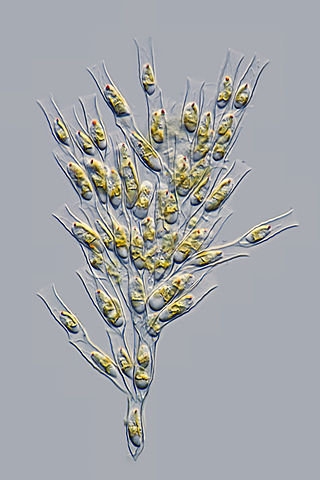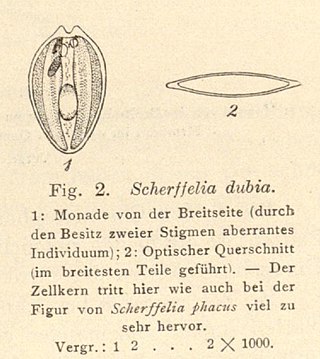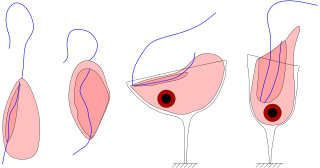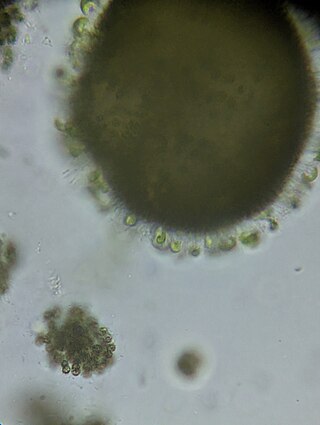
Pedinellales is a group of single-celled algae found in both marine environments and freshwater.
Cryptomonas is the name-giving genus of the Cryptomonads established by German biologist Christian Gottfried Ehrenberg in 1831. The algae are common in freshwater habitats and brackish water worldwide and often form blooms in greater depths of lakes. The cells are usually brownish or greenish in color and are characteristic of having a slit-like furrow at the anterior. They are not known to produce any toxins. They are used to feed small zooplankton, which is the food source for small fish in fish farms. Many species of Cryptomonas can only be identified by DNA sequencing. Cryptomonas can be found in several marine ecosystems in Australia and South Korea.

Chromulinales is an order of Chrysophyceae, golden-brown algae or golden algae. It was first identified and defined by Adolf Pascher (1881–1945) in 1910.

Gagea is a large genus of spring flowers in the lily family. It is found primarily in Eurasia with a few species extending into North Africa and one species in North America.

The cryptophyceae are a class of algae, most of which have plastids. About 230 species are known, and they are common in freshwater, and also occur in marine and brackish habitats. Each cell is around 10–50 μm in size and flattened in shape, with an anterior groove or pocket. At the edge of the pocket there are typically two slightly unequal flagella.

Eustigmatophytes are a small group of eukaryotic forms of algae that includes marine, freshwater and soil-living species.

Scherffelia is a genus of green algae in the family Chlorodendraceae.

Jakobids are an order of free-living, heterotrophic, flagellar eukaryotes in the supergroup Excavata. They are small, and can be found in aerobic and anaerobic environments. The order Jakobida, believed to be monophyletic, consists of only twenty species at present, and was classified as a group in 1993. There is ongoing research into the mitochondrial genomes of jakobids, which are unusually large and bacteria-like, evidence that jakobids may be important to the evolutionary history of eukaryotes.
Gilbert Morgan Smith was a botanist and phycologist, who worked primarily on the algae. He was best known for his books, particularly the Freshwater Algae of the United States, the Marine Algae of the Monterey Peninsula and the two volumes of Cryptogamic Botany.
Olpidiaceae is a fungal plant pathogen family of genera that was placed in the order Olpidiales.
Spirulina agilissima is a freshwater cyanobacteria from the genus Spirulina.

Chrysococcus is a genus of golden algae in the family Dinobryaceae.
Cryptochrysis is a formerly recognized genus of cryptomonads first proposed by Adolf Pascher in 1911. He initially treated it as the sole genus in family Cryptochrysidaceae, but later treated it as a member of the Cryptochrysideae subfamily of Cryptomonadaceae, along with Rhodomonas, Chroomonas, and Cyanomonas. In 1967, R.W. Butcher relegated the group to a subgenus within Chroomonas.
Eutreptiella is a genus of Euglenozoa belonging to the family Eutreptiidae.
Acanthoica is a genus of algae belonging to the family Rhabdosphaeraceae.
Chlorothecium is a genus of algae belonging to the family Characiopsidaceae.

Characiopsidaceae is a family of algae belonging to the order Mischococcales.
Hyaloraphidium is a genus of chytrid-like fungi. It is the only member of the family Hyaloraphidiaceae, order Hyaloraphidiales and class Hyaloraphidiomycetes in the division Monoblepharomycota.
Saturnella is a genus of algae belonging to the family Oocystaceae.








